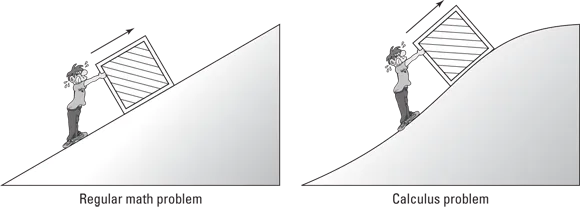![]()
Part 1
An Overview of Calculus
IN THIS PART …
A brief and straightforward explanation of just what calculus is. Hint: It’s got a lot to do with curves and with things that are constantly changing.
Examples of where you might see calculus at work in the real world: curving cables, curving domes, and the curving path of a spacecraft.
The first of the two big ideas in calculus: differentiation, which means finding a derivative. A derivative is basically just the fancy calculus version of a slope; and it’s a simple rate — a this per that.
The second big calculus idea: integration. It’s the fancy calculus version of adding up small parts of something to get the total.
An honest-to-goodness explanation of why calculus works: In short, it’s because when you zoom in on curves (infinitely far), they become straight.
![]()
Chapter 1
What Is Calculus?
IN THIS CHAPTER
You’re only in Chapter 1 and you’re already going to get your first calc test
Calculus — it’s just souped-up regular math
Zooming in is the key
The world before and after calculus
“My best day in Calc 101 at Southern Cal was the day I had to cut class to get a root canal.”
— MARY JOHNSON
“I keep having this recurring dream where my calculus professor is coming after me with an axe.”
— TOM FRANKLIN, COLORADO COLLEGE SOPHOMORE
“Calculus is fun, and it’s so easy. I don’t get what all the fuss is about.”
— SAM EINSTEIN, ALBERT’S GREAT-GRANDSON
In this chapter, I answer the question “What is calculus?” in plain English, and I give you real-world examples of how calculus is used. After reading this and the following two short chapters, you will understand what calculus is all about. But here’s a twist: Why don’t you start out on the wrong foot by briefly checking out what calculus is not?
What Calculus Is Not
No sense delaying the inevitable. Ready for your first calculus test? Circle True or False.
- True or False: Unless you actually enjoy wearing a pocket protector, you’ve got no business taking calculus.
- True or False: Studying calculus is hazardous to your health.
- True or False: Calculus is totally irrelevant.
False, false, false! There’s this mystique about calculus that it’s this ridiculously difficult, incredibly arcane subject that no one in their right mind would sign up for unless it was a required course.
Don’t buy into this misconception. Sure, calculus is difficult — I’m not going to lie to you — but it’s manageable, doable. You made it through algebra, geometry, and trigonometry. Well, calculus just picks up where they leave off — it’s simply the next step in a logical progression.
And calculus is not a dead language like Latin, spoken only by academics. It’s the language of engineers, scientists, and economists. Okay, so it’s a couple steps removed from your everyday life and unlikely to come up at a cocktail party. But the work of those engineers, scientists, and economists has a huge impact on your day-to-day life — from your microwave oven, cell phone, TV, and car to the medicines you take, the workings of the economy, and our national defense. At this very moment, something within your reach or within your view has been impacted by calculus.
So What Is Calculus, Already?
Calculus is basically just very advanced algebra and geometry. In one sense, it’s not even a new subject — it takes the ordinary rules of algebra and geometry and tweaks them so that they can be used on more complicated problems. (The rub, of course, is that darn other sense in which it is a new and more difficult subject.)
Look at Figure 1-1. On the left is a man pushing a crate up a straight incline. On the right, the man is pushing the same crate up a curving incline. The problem, in both cases, is to determine the amount of energy required to push the crate to the top. You can do the problem on the left with regular math. For the one on the right, you need calculus (assuming you don’t know the physics shortcuts).
For the straight incline, the man pushes with an unchanging force, and the crate goes up the incline at an unchanging speed. With some simple physics formulas and regular math (including algebra and trig), you can compute how many calories of energy are required to push the crate up the incline. Note that the amount of energy expended each second remains the same.
For the curving incline, on the other hand, things are constantly changing. The steepness of the incline is changing — and not just in increments like it’s one steepness for the first 3 feet then a different steepness for the next 3 feet. It’s constantly changing. And the man pushes with a constantly changing force — the steeper the incline, the harder the push. As a result, the amount of energy expended is also changing, not every second or every thousandth of a second, but constantly changing from one moment to the next. That’s what makes it a calculus problem. By this time, it should come as no surprise to you that calculus is described as “the mathematics of change.” Calculus takes the regular rules of math and applies them to fluid, evolving problems.
For the curving incline problem, the physics formulas remain the same, and the algebra and trig you use stay the same. The difference is that — in contrast to the straight incline problem, which you can sort of do in a single shot — you’ve got to break up the curving incline problem into small chunks and do each chunk separately. Figure 1-2 shows a small portion of the curving incline blown up to several times its size.
When you zoom in far eno...


